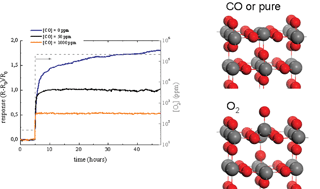Metal oxides present oxygen defects that induce different chemical and physical properties. Experiments performed in SnO2-x sensors show that the dynamics of these vacancies are strongly affected by the presence of different gases in the environment. Experimentally, the electrical resistance of individual metal oxide SnO2-x nanowires shows modulation: when the environment is oxygen rich long term drifts (hours) are observed indicating extended vacancy dynamics. Instead, if CO is present, drifts disappear in minutes. Density functional theory indicates that changes in resistance follow the extension of reoxidation. For oxygen-poor environments, oxygen vacancy excorporation and healing are confined to the near-surface layer of SnO2-x (bidimensional or near-surface diffusion), and completed in short times. Under oxygen-rich conditions, tridimensional diffusion of oxygen vacancies towards the surface takes place at room temperature. In this case, a push-pull mechanism allows bulk-to-surface diffusion and as a consequence resistance drifts are longer and the vacancy quenching is more extensive.
